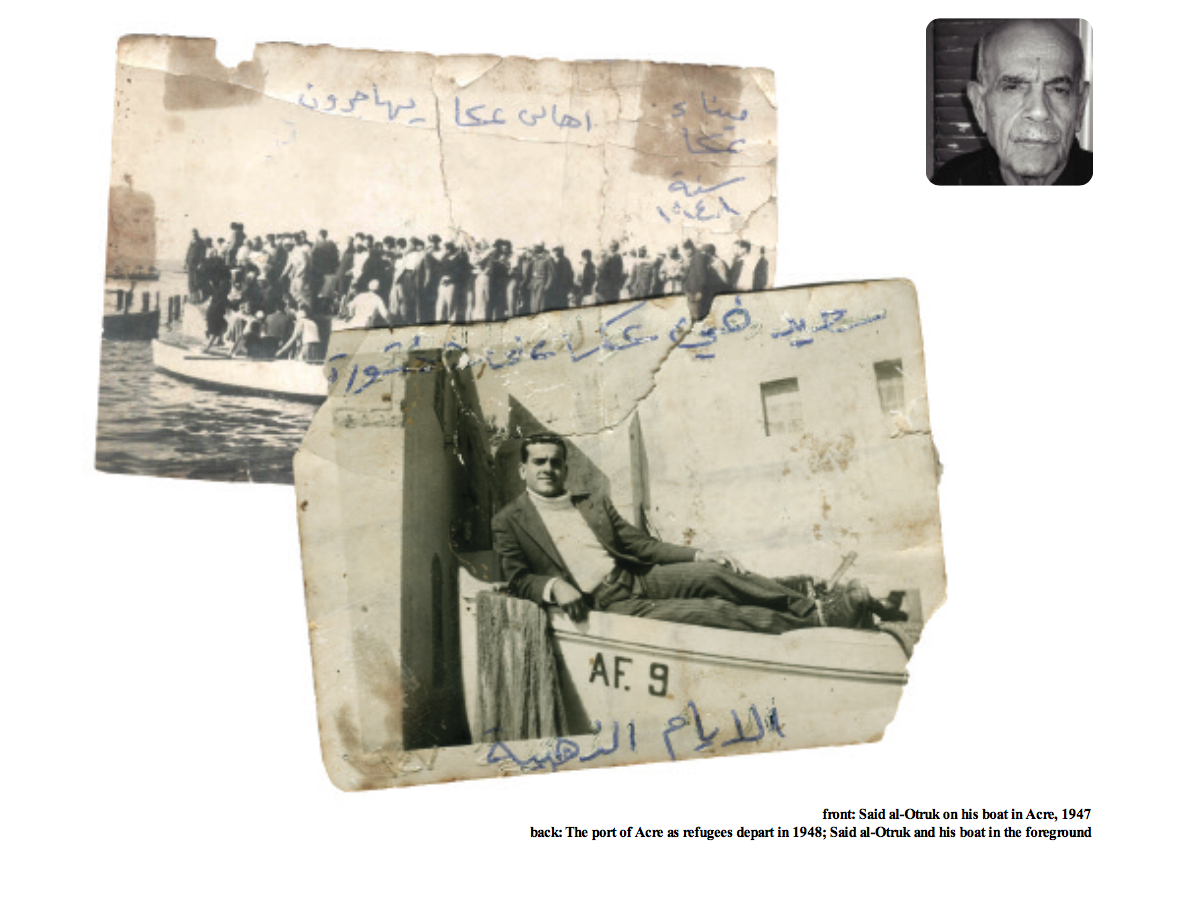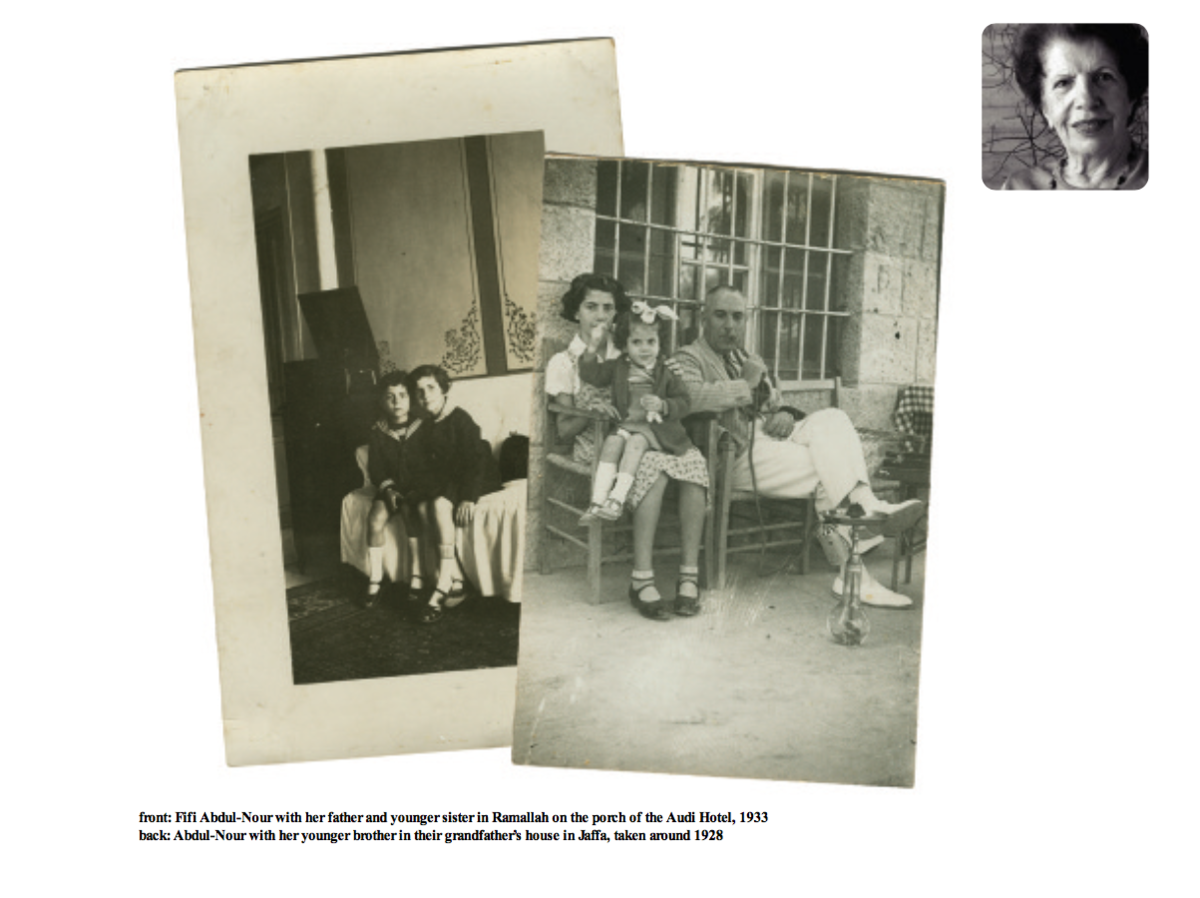
For first generation Palestinian refugees living in Lebanon, the photographs that survived the displacement in 1948 and were carried with them into exile not only evoke memories of Palestine as it used to be; for many refugees they are often crucial to a present sense of self. These images and narratives form part of an ongoing project, Photo48, which brings together personal photographs and memories that bear witness to the ongoing legacy of 1948 in the lives of refugees in the diaspora today. Photo48 was initiated by the Nakba Archive, an independent research collective document local histories of 1948, in association with Bidoun. By Diana Allan and Mahmoud Zeidan


**Hussein Mohammad Zaghmout was born in Sufsaf in 1929; he now lives in Ayn al-Hileh camp in south Lebanon.
The photo was taken in Haifa in 1947 in Souk al-Abyad. I’m on the right; in the middle is Mirie Hassan and to the left is Mohammed Qassim. We were on leave from the British army, where we were working as patrol guards for the Palestine police force. At that time we were training in Lydd and Ramleh. I remember once while we were training, we had an accident in Mlabas and Khodiara, and I lost consciousness. I woke up in the hospital while they were stitching my wounds. Mirie fed me cookies and they gave me ten days of sick leave…they sent us to different areas. I went to Gaza, where I served for ten months. When the skirmishes between the Jews and the Arabs began we returned to our village. They promised to give us retirement funds, but when I went back to Gaza they only gave me only one month’s pay. When we left Sufsaf in 1948 we went first to the village of Ras al-Ahmar and then on to Yaroun, where we rented a house for almost a month. Then one day the mukhtar (mayor) came and told us that the village was occupied and that people had been massacred…I keep this photo in my wallet; I like to have it with me always so that I can look at it.
Said Al-Otruk was born in Acre in 1922; he now lives in the old Souk in Sidon where he owns a small electrical shop.
Someone called Mahmoud Mamish took this picture of me on my boat in the old port of Acre. He was also from Acre, though he owned three or four cinemas in Beirut. I remember the old days— days of freedom! Work at sea is freedom…whenever you need money you can go out and catch some fish for yourself.The life of a fisherman at this time was golden, which is why I wrote “The golden days” on this photograph. One never needed to go far from home—perhaps around 500 meters—the fish would be waiting for us,sardine and sfarneh, a snake-like fish.After an hour or so we’d come back…God provided for us well. Some people say being a fisherman is hard, but for those who have the right equipment it isn’t. To fish sfarneh and sardine one needs special nets. My boat was number 9…In this shop I feel as if I’m confined; It’s a prison where I spend my days from seven in the morning until five in the evening, or later. Selling electrical appliances is not my job; I’m a fisherman! Because my brother learned electricity in Acre and started a shop there, I learned the trade while I helped him with his accounts in th e evenings, after I’d finished my work.Then when we came to Lebanon he started another shop, so I also helped him here, and then I ended up having my own store…When people started to flee from Acre in 1948, boats like mine were used to take people to the larger steamers that were waiting off shore. You see my boat here in this picture—you see the number 9? I am standing next to it. I’ve put a cross above my head so you can find me. There were three different steamers that you could choose from, with different flags. One went to the port of Hama in Syria, another to Alexandria in Egypt, and the third to Lebanon…People left in such a hurry, leaving everything. Taraku jamal bi ma hamal! [They left the camel with its load]. When I see these pictures I feel bitter.
Fifi Abdul-Nour was born in Jaffa in 1923; she now lives in Beirut.
We used to spend the summers in Ramallah, where many families from Jaffa owned homes. This picture was taken there in 1933, I think. My younger sister is on my lap and we are sitting with my father on the porch of the Audi Hotel. The house we rented was across from the hotel, so we’d walk through the garden and sit there in the evenings. My father liked to play cards there and smoke nargileh. A young man called Ito Beiruti, an amateur photographer from Jaffa, took this picture. I remember thinking, as a child, thinking how strange he seemed. One day, which I’ll never forget, we followed him through the streets in Jaffa near our house, singing some rhyme like “Ito afa ita…” and he chased us through the streets and gave us a big spanking when he caught us…This is the other picture I treasure: It’s of my younger brother and me at my grandfather’s house in Jaffa where we lived for some time. It was luxurious: The living room was thirteen meters long, and there was an inner courtyard with an enormous jasmine. I used to collect the buds and make garlands from them, like the ones you see people selling by the side of the road here. The layout and interior was designed by an Italian architect, and I particularly loved the walls. They were pale blue, painted to look like marble, and the patterns you see behind us were a darker blue…We visited the house a few years ago and the walls were as you see them here, though the building has been divided into a number of apartments. Next to us is a phonograph, which was unusual in those days; when my father went on business trips to Paris he’d bring us back records to listen to. In the last months before we left I remember that from time to time shots were fired at the houses in Jaffa from neighboring Tel Aviv. One evening my brother woke up and saw what he thought was a huge spider on the mirror. Then we saw a hole in the shutters where a bullet had gone through, and later we found it on the floor in the corner of the room…